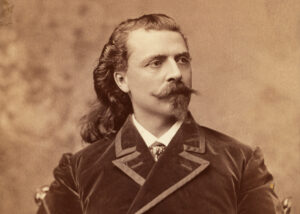You don’t have to believe in ghosts to like a good ghost story. Although a confirmed skeptic myself, I’ve long been attracted to tales of the mysterious and unexplained. So when I first came across the story of Margery the medium, I was fascinated. Margery and her exploits are interesting by themselves, but once you add Harry Houdini and Sir Arthur Conan Doyle to the mix you have more material than you could possibly pack into a single magazine article.
In fact, the lives of both those public figures provide enough material for entire books. For a time the two men were friends, even though they were opposites in many ways. Houdini was small and intense and a natural skeptic when it came to the supernatural. Conan Doyle was big, bluff, and hearty and the world’s best-known believer in spiritualism. Conan Doyle was fascinated by the world-famous escape artist and hoped to win him over to his side of the issue. Houdini enjoyed the company of the well-known author, even though he considered him woefully gullible about the supernatural.
Ultimately, their differing viewpoints ended the friendship. The final break came as a result of a séance they held in Atlantic City. Conan Doyle hoped to use the occasion to submit definitive proof to Houdini that the living could communicate with the dead. Acting as the medium was the author’s own wife, Jean, who had developed talents of “automatic writing,” when she entered a trance-like state and wrote down messages from the beyond. On this occasion she took her otherworldly dictation from Houdini’s beloved (and very dead) mother. Yet Houdini asked himself how his Hungarian mother managed to communicate in clear English, a language she never learned. It was the last straw for Conan Doyle. How dare Houdini doubt his own wife! The former friends ended up exchanging barbs through the press until Houdini’s death in 1926. Conan Doyle remained intrigued by Houdini, though, and by the end of his own time on earth was certain the magician had possessed genuine paranormal abilities. “I have no more doubt that he used psychic powers than I have that I am dictating this letter,” he told one correspondent.
“There are more things in heaven and earth, Horatio/Than are dreamt of in your philosophy,” Shakespeare’s Hamlet told his down-to-earth pal. That’s a point believers in the supernatural like to make to the skeptical. Yet Hamlet’s words cut both ways, for quite often it was the believers who were unable to imagine the great breadth of human imagination and chicanery that allowed mediums to hoodwink their audiences. Some employed small dabs of luminous paint so they could identify cards in a pitch-black séance room, while others used their feet to perform stunts they attributed to supernatural forces. (Houdini liked to demonstrate how he could surreptitiously remove his foot from his shoe and ring a bell with his toes, without the others at the table knowing he was doing it.)
When people truly wanted to believe, changing their minds was next to impossible. Conan Doyle remained steadfast in his belief until he died. He would even champion mediums who had been caught cheating. “We must not argue that because a man once forges, therefore he has never signed an honest check in his life,” he said. Houdini, who had conducted fake séances when he was a young magician, knew how to fool people. Conan Doyle did not. “Being uninitiated in the world of mystery, never having been taught the artifices of conjuring, it was the simplest thing in the world for anyone to . . . hoodwink him,” Houdini said.
As for Margery…to this day some of her effects remain unexplained. (In fact, so do some of Houdini’s.) Perhaps it’s for the best. For what is life without a little mystery?
Tom Huntington, Editor, American History




